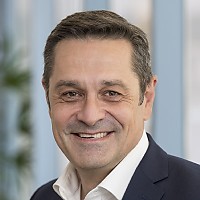It was no different in late April, when he told an audience at the Alpha Live Conference in Sydney the sovereign wealth fund was allocating more money to active equity fund managers.
His remarks reignited the discussion about whether active managers are worth their salt or if the perceived difficulty of consistently outperforming a benchmark should encourage investors to largely invest in passive index-tracking funds.
“Around six years ago, we pivoted our listed equities approach away from active managers. At that time, markets were being driven by central bank policies and our view was that it was nigh on impossible for active equities managers to consistently add value over and above their fees,” Arndt said.
The rationale for its shift is rooted in the significant and rapid change that characterises the global environment. For example, an extended period of benign geopolitics has been interrupted by war in Europe and a ramp up in defence spending in Australia’s own region.
The world is also deglobalising and governments are seeking to direct capital investment – a practice which typically detracts from potential economic growth.
“A previously considered safe investment like an office building or shopping centre is no longer safe. A large cap company can be split up, regulated or its markets disrupted. There are no set-and-forget investments anymore,” Arndt said.
“Economies are diverging and companies can better distinguish themselves in a more challenging environment. As a result, active alpha-seeking strategies in our $65 billion listed equities program are increasingly attractive, provided that we can be confident that returns are driven by skill and not luck.”
Active scorecard
His latter point around the skill level of active management makes sense when considered in the context of the SPIVA Australia Scorecard, which is compiled by S&P Dow Jones Indices. The latest scorecard found only 42.4 per cent of general Australian equity funds outperformed the benchmark S&P/ASX 200 in 2022.
Over longer periods, out-performance rates were even lower with just 18.8 per cent and 16.4 per cent of funds doing better than the S&P/ASX 200 over five and 15 years, respectively.
Australian equity mid- and small-cap funds had an even more challenging 2022 but can boast a better long-term record, with 45.3 per cent outperforming the relevant benchmark over 15 years.
In the US, the discrepancy between active and passive managers was not as significant in 2022, with close to half of all large cap funds outperforming the benchmark S&P 500 Index. Over longer periods though, the result was quite different – only 13.5 per cent outperformed the market over five years and over 15 years that dropped to 6.6 per cent.
Do others hold the same view as Arndt – that it’s worth sifting through available managers to determine which ones have the greatest likelihood of earning their generally higher fees? The obvious answer is that it depends on who you ask as there is no single definitive answer to this time-old question.
For advisers who wish to include active funds in portfolios, recent Morningstar research into US large growth funds, The Big Shortcoming, provides insights which could potentially be applied to other areas too. For example, it suggested fees alone were not a root cause of active manager underperformance.
It was true two-thirds of the managers that beat the index charged below average fees – but gross returns from the typical manager also struggled to beat the benchmark.
Other Morningstar research shows the success rate of active managers varies across sectors and that investors can use this data to identify areas where they might have a higher chance of selecting investments that will outperform.
Active ETFs to increase
Unlisted funds have been a traditional route into active investments but ASX-listed ETFs that seek to add value, are growing in number too.
They form a smaller part of the local ETF pie than well-established passive vehicles but are part of a global trend in which net inflows into active ETFs reached US$102 billion in 2022, versus net outflows of US$1.5 trillion from active mutual funds.
Indeed, a recent PwC report, ETFs 2027: A world of new possibilities, found that global providers believe active ETFs are set to attract the most demand outside conventional vehicles used as a portfolio core over the next two to three years.
“Right now, the bulk of ETF investment and growth remain focused on traditional equity and fixed income strategies,” PwC said. “However, over-reliance on traditional products could put ETF managers at risk of being disrupted by competitors with superior scale, technology, and brand awareness. Forward-thinking managers are therefore stepping up the pace of product innovation as they look to diversify and differentiate their offerings.”
ASX-listed active equity ETFs include Antipodes Global Shares (ASX: AGX1), WCMQ Quality Global Fund (ASX: WCMQ), and Airlie Australian Share Fund (ASX: AASF), among others.
Several fund managers have sought to capitalise on the burgeoning demand by creating ETF versions of existing unlisted funds available in Australia, giving investors a choice about which structure to use.
US respondents to PwC’s survey expect active ETFs which provide full transparency of their holdings will be most popular in coming years, though both US and Australian requirements do allow semi-transparent products.
One thing for certain is that active exchange traded funds will keep coming and provide opportunities for advisers to consider adding different investments to clients’ portfolios.
Brett Grant, head of product, customer experience and marketing, AUSIEX


